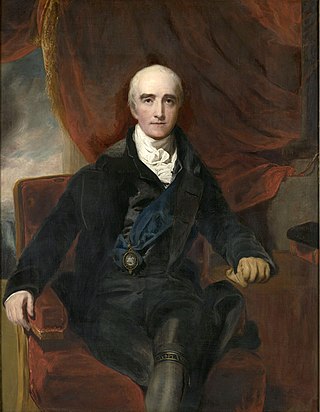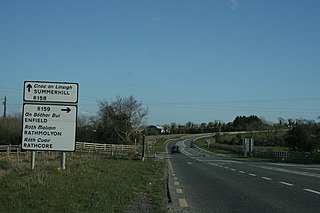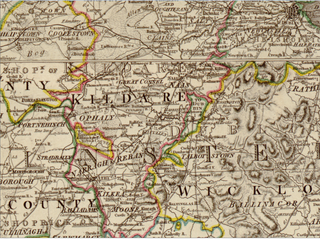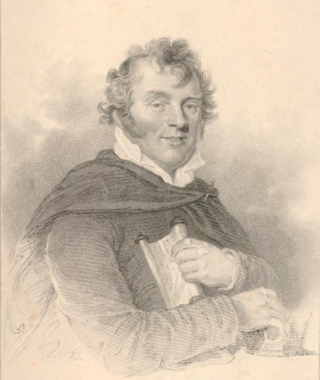
Duke of Wellington is a title in the Peerage of the United Kingdom. The name derived from Wellington in Somerset. The title was created in 1814 for Arthur Wellesley, 1st Marquess of Wellington, the Anglo-Irish military commander who is best known for leading the decisive victory with Field Marshal von Blücher over Napoleon's forces at Waterloo in Brabant. Wellesley later served twice as British prime minister.

Richard Colley Wellesley, 1st Marquess Wellesley, was an Anglo-Irish politician and colonial administrator. He was styled as Viscount Wellesley until 1781, when he succeeded his father as 2nd Earl of Mornington. In 1799, he was granted the Irish peerage title of Marquess Wellesley. He was also Lord Wellesley in the Peerage of Great Britain.

Earl of Mornington is a title in the Peerage of Ireland. It was created in 1760 for the Anglo-Irish politician and composer Garret Wellesley, 2nd Baron Mornington. On the death of the fifth earl in 1863, it passed to the Duke of Wellington; since that date, the title has generally been used by courtesy for the heir apparent to the heir apparent to the dukedom.

Earl Cowley is a title in the Peerage of the United Kingdom. It was created in 1857 for the diplomat Henry Wellesley, 2nd Baron Cowley. He was Ambassador to France from 1852 to 1867. He was made Viscount Dangan, of Dangan in the County of Meath, at the same time as he was given the earldom. This title is also in the Peerage of the United Kingdom. Lord Cowley was the eldest son of Henry Wellesley, 1st Baron Cowley, who like his son served as Ambassador to France. In 1828 he was created Baron Cowley, of Wellesley in the County of Somerset, in the Peerage of the United Kingdom. A member of the prominent Wellesley family, Cowley was the fifth and youngest son of Garret Wellesley, 1st Earl of Mornington, and the younger brother of Arthur Wellesley, 1st Duke of Wellington, and Richard Wellesley, 1st Marquess Wellesley.

William Wellesley-Pole, 3rd Earl of Mornington,, known as Lord Maryborough between 1821 and 1842, was an Anglo-Irish politician and an elder brother of the Duke of Wellington. His surname changed twice: he was born with the name Wesley, which he changed to Wesley-Pole following an inheritance in 1781. In 1789 the spelling was updated to Wellesley-Pole, just as other members of the family had changed Wesley to Wellesley.

Garret Colley Wesley, 1st Earl of Mornington was an Anglo-Irish politician and composer, as well as the father of several distinguished military commanders and politicians of Great Britain and Ireland.

Mornington House was the Dublin social season Georgian residence of the Earls of Mornington. It is Number 24 Merrion Street, close to Leinster House, the former city residence of the Dukes of Leinster, where the Irish parliament now sits.

William Pole-Tylney-Long-Wellesley, 4th Earl of Mornington was an Anglo-Irish nobleman notorious for his dissipated lifestyle.

Agher is a crossroads and townland in County Meath, Ireland. It is located 3 km (1.9 mi) southwest of Summerhill.

Summerhill is a heritage village in County Meath, Ireland. It is located in the south of the county, between Trim and Kilcock on the R158 and west of Dunboyne on the R156.
Garret Wesley was an Irish Member of Parliament.

Richard Colley Wesley, 1st Baron Mornington was an Irish peer, best remembered as the grandfather of Arthur Wellesley, 1st Duke of Wellington.
Dudley Colley was an Irish Member of Parliament.
Henry Colley was an Irish Member of Parliament. He was a member of the same family as the Duke of Wellington.
Henry Colley (1648–1719) was an Irish Member of Parliament.

Laracor, in Irish Láithreach Cora, is a civil parish which is located in County Meath in Ireland, south of Trim. It overlaps with the electoral division of the same name.

The High Sheriff of Kildare was the British Crown's judicial representative in County Kildare, Ireland from the 16th century until 1922, when the office was abolished in the new Free State and replaced by the office of Kildare County Sheriff. The High Sheriff had judicial, electoral, ceremonial and administrative functions and executed High Court Writs. In 1908, an Order in Council made the Lord Lieutenant the Sovereign's prime representative in a county and reduced the High Sheriff's precedence. However, the sheriff retained his responsibilities for the preservation of law and order in the county. The usual procedure for appointing the sheriff from 1660 onwards was that three persons were nominated at the beginning of each year from the county and the Lord Lieutenant then appointed his choice as High Sheriff for the remainder of the year. Often the other nominees were appointed as under-sheriffs. Sometimes a sheriff did not serve his full term due to death or another event, and another sheriff was then appointed for the remainder of the year. The dates given in this article are the dates of appointment.
The Custos Rotulorum of Meath was the highest civil officer in County Meath. The position was later combined with that of Lord Lieutenant of Meath.

Roger O'Connor (1762-1834) was an Irish nationalist and writer, known for the controversies surrounding his life and writings, notably his fanciful history of the Irish people, the Chronicles of Eri. He was the brother of the United Irishman Arthur O'Connor, and the father of the Chartist leader Feargus O'Connor and of Francisco Burdett O'Connor who was to fight in the Spanish American wars of independence.
















